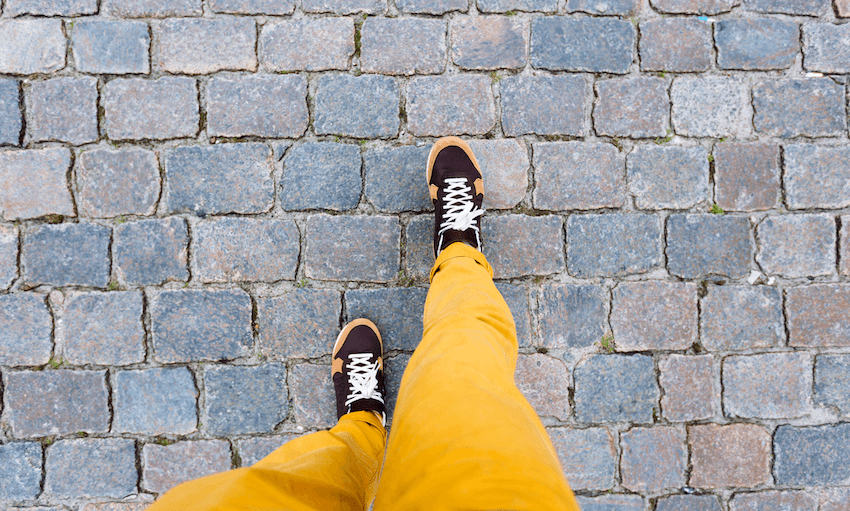The clash between urban cyclists and car drivers has been brewing for several years now. But pedestrians have been advocating for their rights far longer, writes Stephen Day.
Not so long ago, the journalist Bernard Hickey predicted that cyclists vs motorists will become one of the political issues of our age. “We are going to fight for our cities and for that space on the roads and the footpaths – and it’s going to be a battle royale!” the ardent Wellington-based cyclist proclaimed.
But this is not a two-way battle with armies standing on each side of a grassy field raising their flags and charging at each other. As any watcher of the fantasy genre knows, there is always at least one other army hiding in the wings ready to outflank one or the other sides.
This war for our streets could well be the Battle of the Five Armies. Because, as well as cyclists and motorists, there are public transport riders and pedestrians. And, adding a bit of sci-fi to the fantasy, e-bikes and e-scooters.
I belong to a small brigade within the pedestrian army, the run commuters. Most mornings I suit up for battle in my singlet and noticeably short shorts. I belt on my bum-bag containing wallet and phone. I step out the door, give a wave to the bus driver whom I often beat into town, and make my way along the busy arterial streets.
I remember many years ago reading someone describe Peter Jackson’s first Lord of the Rings film The Fellowship of the Ring as a tribute to tramping, and his second The Two Towers as a tribute to running. Thankfully he did not make too many more LOTR films because the fourth would surely have been a tribute to trying to catch a Wellington bus to the battle, arriving late, and finding the survivors had already gone to the Realm for the after-battle feast.
I’ve been a run commuter for a long time. But I got somewhat spiritual about it a few years ago after reading Christopher McDougall’s ultrarunning bible Born to Run. McDougall suggests that because humans can sweat to cool ourselves and can run for long a long time on two legs, we may have evolved and survived by chasing other animals over the savannah for long distances until they overheated and collapse into a readily consumable meal for us.
By running to work each day I imagine I am fulfilling my biological imperative to support my family with exhausted buffalo meat each day. No matter that my family is semi-vegetarian, and vegetables don’t need much chasing before you can eat them. McDougall’s theory has subsequently been challenged by some, but the romance of the chase remains for distance runners like me.
We running pedestrians are like our walking brethren, but we can travel longer distances in a shorter time and we don’t smell as good. Just as cyclists zipping in and out of traffic drive motorists bananas, runners zipping across the footpath, sidestepping oncoming walkers, and dashing across zebra crossings drive our fellow pedestrians nuts.
But, despite that, we are their allies in this culture war. In fact, we are allies with everyone in the war because we want the same thing – a fast, pleasant, safe, not-too-stressful journey to and from work. For everyone, including motorists, that translates to fewer cars on the road, and safe separation between the things that are bigger and faster than your current mode of transport.
The solution comes down to design. For pedestrians and cyclists, good tracks and trails that take us away from the roads are often the most enjoyable as well as the cheapest solution. In Wellington the town belt lets many residents make their way to town through nature – the very same nature that inspired Lord of the Rings’ less violent scenes.
Enabling these kinds of track and trails takes foresight. The original Wellington town planners who protected a town belt in 1840 have saved the city immeasurable transport woes.
It’s hard to retrofit good transport design onto bad urban design. That’s why the Walking Access Commission Ara Hīkoi Aotearoa is working hard to help plan good public access before the houses get built in peri-urban areas like the northern reaches of Auckland, and further south at the Auckland/Waikato boundary around growing communities like Pukekohe and Pokeno.
(Disclosure: the Walking Access Commission is the place where I run to work to hunt my buffalo)
In and around Matakana, the commission is working with Auckland Council, the Matakana Coast Trail Trust, Ngāti Manuhiri, the Department of Conservation and the NZ Transport Agency to create a network of trails on the northern boundary of Auckland, from Pūhoi to Pākiri.
To the south, the commission is working with the Waikato District Council, the Waikato Regional Council, the Franklin Local Board of Auckland Council, Waikato Tainui and others to imagine a network of largely off-road tracks and trails.
Good safe, effective public accessways that connect pedestrians, cyclists, and others (such as horse riders) to our workplaces, schools, nearby shops and communities is the peace treaty that will help us avoid a battle of the five armies. That is, so long as I undo the offence caused by my short running shorts.
